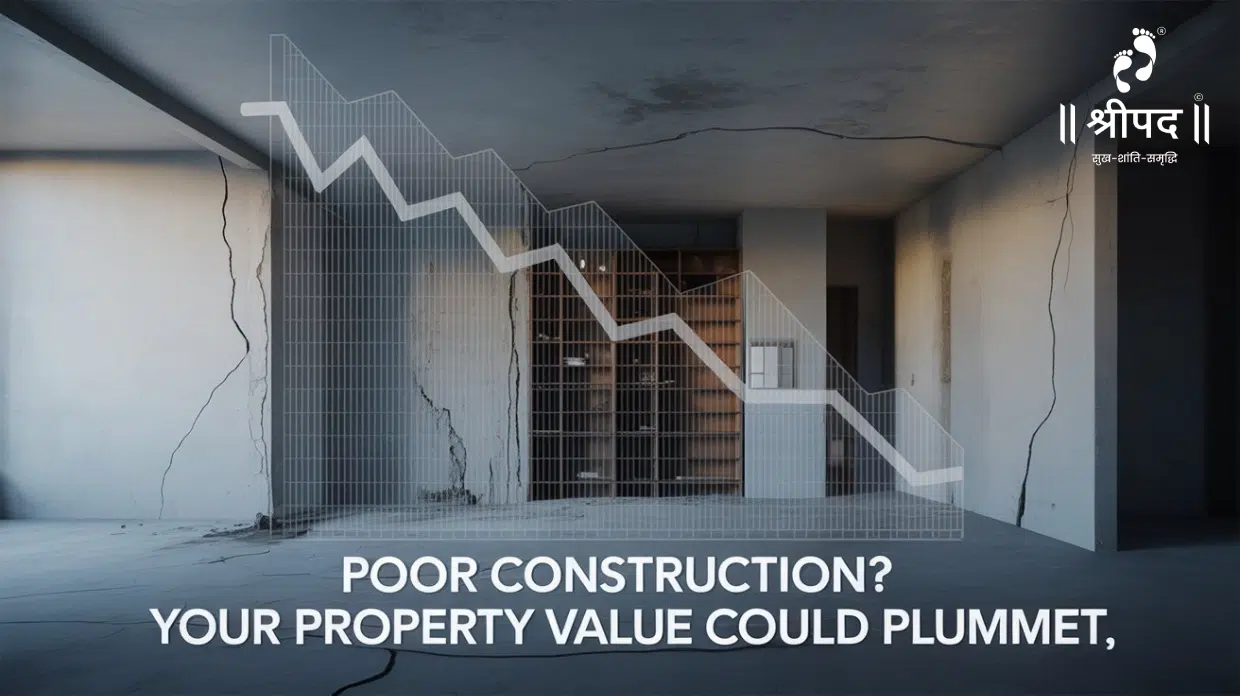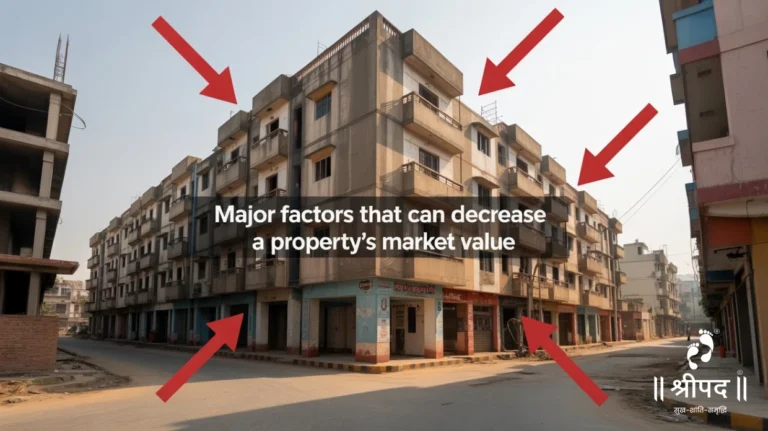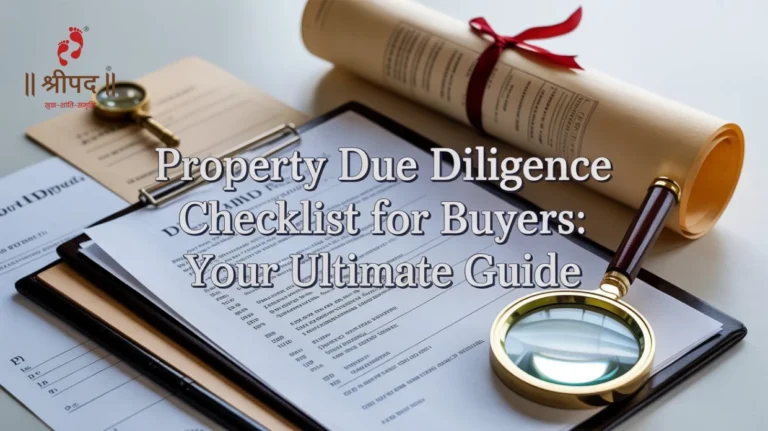- SHREEPAD GROUP
-
+91 83476 68000

When investing in real estate, most people consider location, amenities, and pricing as their top priorities. While these factors are undeniably important, one critical element often goes unnoticed—construction quality.
A property might look elegant at first glance, but if it has been built with inferior materials or careless techniques, its long-term value, durability, and livability will suffer. In fact, poor construction is one of the biggest reasons properties lose their resale potential.
In this article, we’ll discuss how substandard construction reduces property value, the key warning signs to look out for, and why purchasing from a reputed builder is the best safeguard for your investment.
Why Construction Quality is Non-Negotiable
The strength and quality of construction determine a property’s safety, longevity, and overall performance. While interiors and design can be upgraded later, foundational and structural issues are much harder—and costlier—to fix.
A building constructed with superior materials and skilled workmanship not only ensures a secure home for residents but also holds or increases its market value. On the other hand, a poorly constructed property faces issues like frequent repairs, safety risks, and low buyer interest, which inevitably drags down its worth.
The Consequences of Poor Construction on Property Value
Low Buyer Interest
Modern homebuyers are well-informed and cautious. Visible flaws such as cracks, seepage, or uneven surfaces raise instant doubts about construction quality. Properties with such issues tend to remain on the market longer and often sell at a much lower price.
High Maintenance and Repair Bills
Cheap construction materials and shortcuts during building stages often result in recurring problems—leakages, electrical malfunctions, and roof damage. Owners end up spending heavily on constant repairs, making the property less attractive for resale.
Compromised Structural Integrity
If the foundation and support systems are weak, the building may pose serious safety risks. Such defects significantly reduce the appraisal value of the property, as no buyer or lender wants to invest in a risky asset.
Legal and Regulatory Trouble
Poor construction is often linked to violations of building codes or non-adherence to safety norms. This could lead to penalties, disputes, or even demolition orders. Buyers hesitate to purchase such properties, leading to a decline in market value.
Aesthetic Shortcomings
Beyond structural concerns, cosmetic defects like poor paintwork, badly finished walls, or misaligned fittings reduce the appeal of a property. Since first impressions heavily influence purchase decisions, bad finishing directly affects value.
Compromised Safety Features
From faulty wiring to weak staircases and inadequate fire safety, poor construction creates hazards that discourage buyers. A property that isn’t seen as safe will rarely command a good price.
Market Reputation Issues
Buildings or projects that develop a reputation for poor quality suffer from negative word of mouth. Even if some units are in better shape, the overall perception of the project lowers the value of every property in that complex.
Reduced Rental Income
For investors, bad construction not only hurts resale prospects but also lowers rental returns. Tenants generally avoid poorly maintained properties, and even if they rent, they are unwilling to pay premium rents for such homes.
Common Signs of Poor Construction
Spotting signs of poor construction during a property visit can help buyers avoid costly mistakes. Here are a few red flags to watch out for:
Cracks in walls or ceilings – may indicate structural weakness.
Water seepage or dampness – a result of improper waterproofing.
Rusting reinforcements – shows low-quality materials were used.
Uneven flooring or misaligned tiles – reflects careless workmanship.
Loose fittings and exposed wiring – major safety concerns.
Improperly installed doors/windows – suggests poor precision.
Subpar painting or plaster – reveals cost-cutting on finishing.
Spotting several of these red flags should make a buyer reconsider or at least conduct a deeper inspection before investing.
Long-Term Impact of Bad Construction
The effects of poor construction don’t just end with immediate inconveniences. They have a lasting influence on your property investment, such as:
Faster depreciation – Value decreases instead of appreciating.
Difficult resale – Buyers hesitate to invest in such properties.
Loan and insurance challenges – Lenders may reject financing, and insurance premiums may rise.
Ongoing maintenance burden – Eats into the owner’s savings.
Health risks – Mold, dampness, and instability harm residents’ wellbeing.
In short, cutting corners on quality during purchase often costs far more in the long run.
The Role of a Trusted Builder
The easiest way to avoid these pitfalls is to buy from a reputed developer who has a proven track record of quality. Well-established builders ensure:
- Durable raw materials are used.
- Expert engineers and skilled labor are employed.
- Each stage of construction undergoes strict quality checks.
- Projects comply with building and safety regulations.
- Properties are designed for both aesthetics and functionality.
Choosing such an ideal real estate developer ensures that your property not only remains safe and comfortable but also appreciates steadily in value.
How Buyers Can Safeguard Themselves
Here are a few ways buyers can protect their investment:
Research the Builder’s Past Projects – Look at previous track records.
Inspect Model Homes Carefully – Don’t just admire, scrutinize finishes and fittings.
Consider Professional Inspection – Hire experts to assess structural strength.
Check Regulatory Compliance – Ensure the project follows local laws.
Ask About Construction Materials – Transparency is a sign of a good builder.
Think Long-Term – Avoid choosing only based on low cost.
Why Quality is the Future of Real Estate
With increasing buyer awareness, transparency rules, and stricter regulations, construction quality has become a decisive factor in real estate success. Projects that compromise on it lose relevance quickly, while those with high standards continue to attract strong demand and appreciation.
Ultimately, investing in well-built properties is the key to ensuring safety, peace of mind, and steady financial growth.
Final Thoughts
Poor construction doesn’t just affect how comfortable a property is—it directly reduces its resale potential, rental income, and long-term appreciation. While an attractively priced property may seem appealing in the short term, poor build quality can turn it into a liability later.
The smartest choice is to invest in a home from a trusted developer who puts quality first. Doing so not only ensures a safe and durable living space but also maximizes your return on investment.
If you’re planning to buy property in Surat, make sure your choice is backed by strong construction standards and a reliable builder. Shreepad Group has earned a reputation for delivering properties that combine modern design, durability, and long-term value.
With us, you don’t just buy a home—you secure an investment that appreciates over time. Choose Shreepad Group for your next property purchase in Surat and experience the confidence of owning a well-constructed home.
See Related News & Insights Blog

09.10.2025
How to Select the Right Property Type to Suit Your Needs
Purchasing a property is one of the most important financial decisions you can make. Whether it’s your first home, an...

09.10.2025
Essential Tips for Investing in a Growing Real Estate Market
Investing in real estate can be one of the smartest financial decisions when approached with knowledge and strategy. A thriving...

09.10.2025
Major Factors That Can Decrease a Property’s Market Value
In the real estate world, property value is more than just a number — it reflects the strength of your...

09.10.2025
Property Due Diligence Checklist for Buyers: Your Ultimate Guide
Purchasing a property is one of the biggest investments in life. Whether it’s a residential apartment, a commercial space, or...
